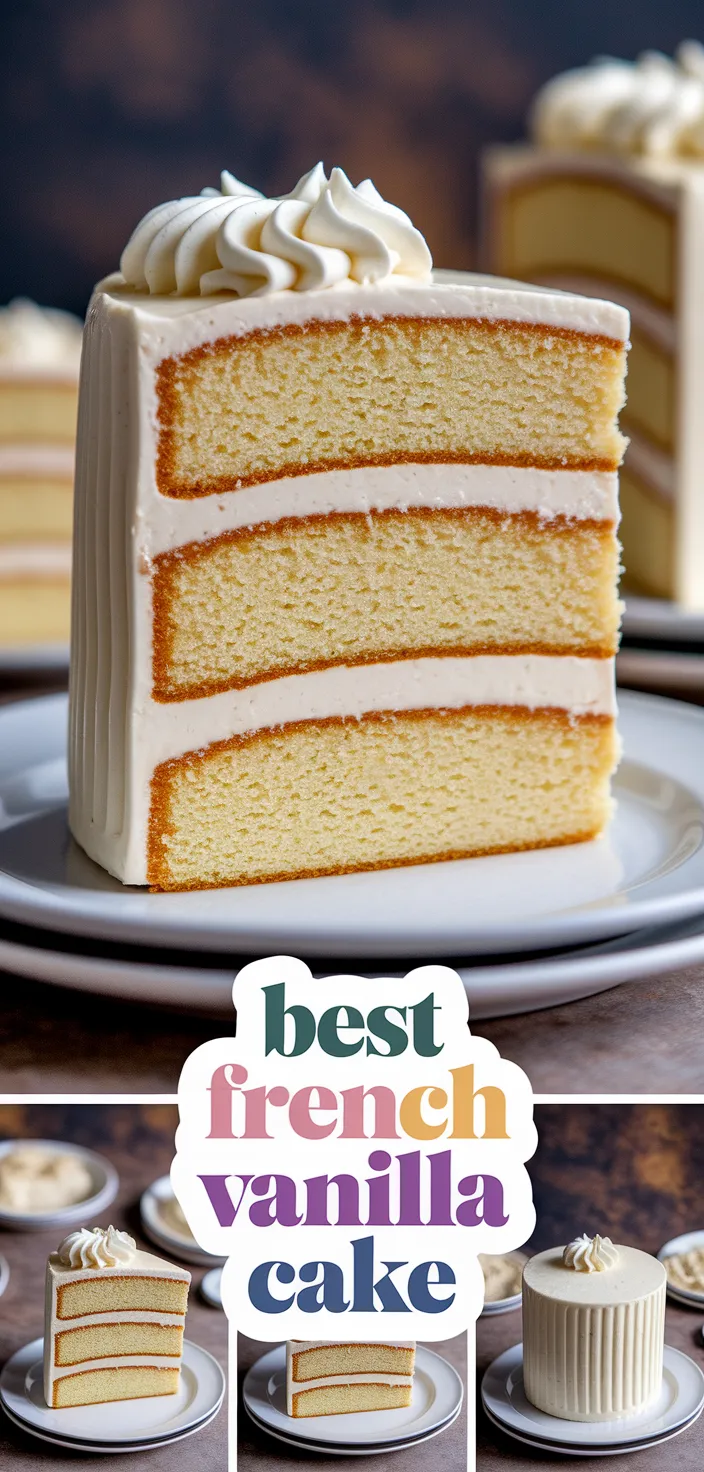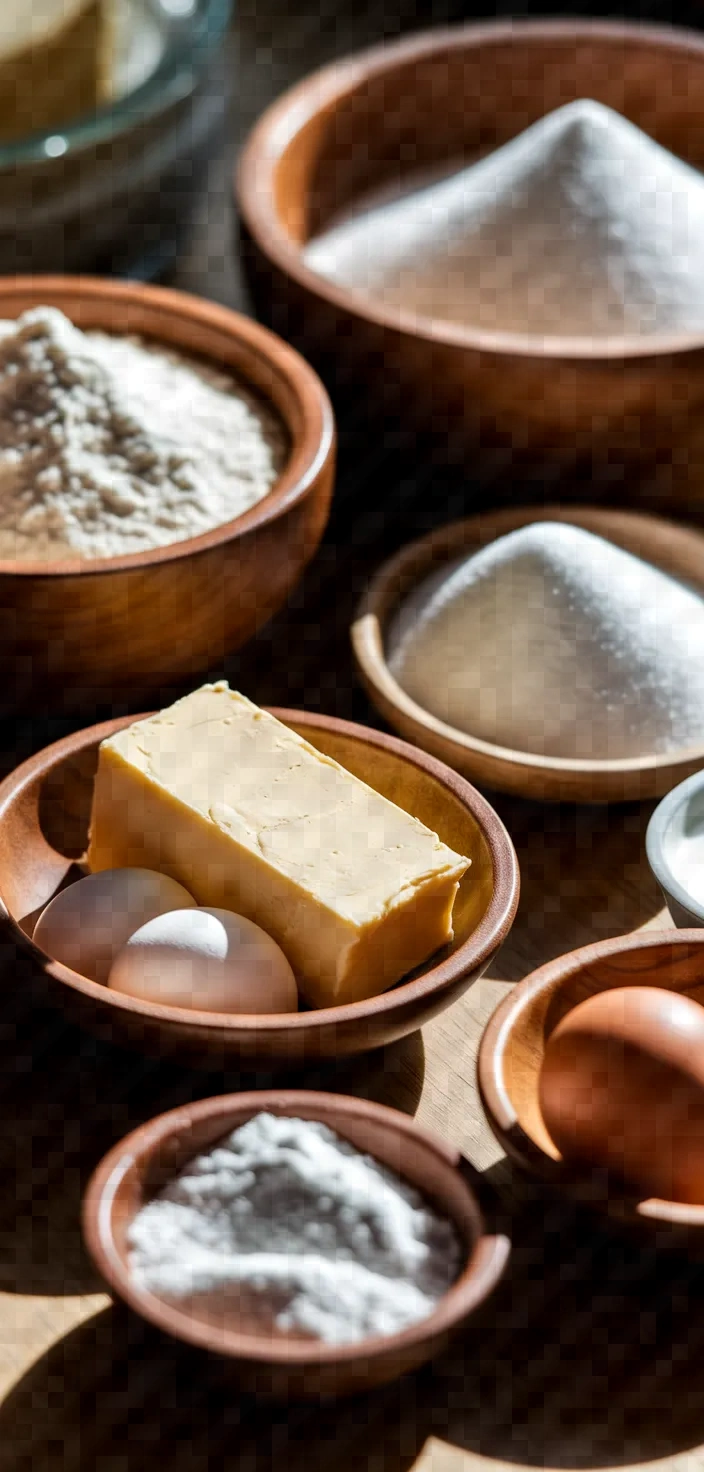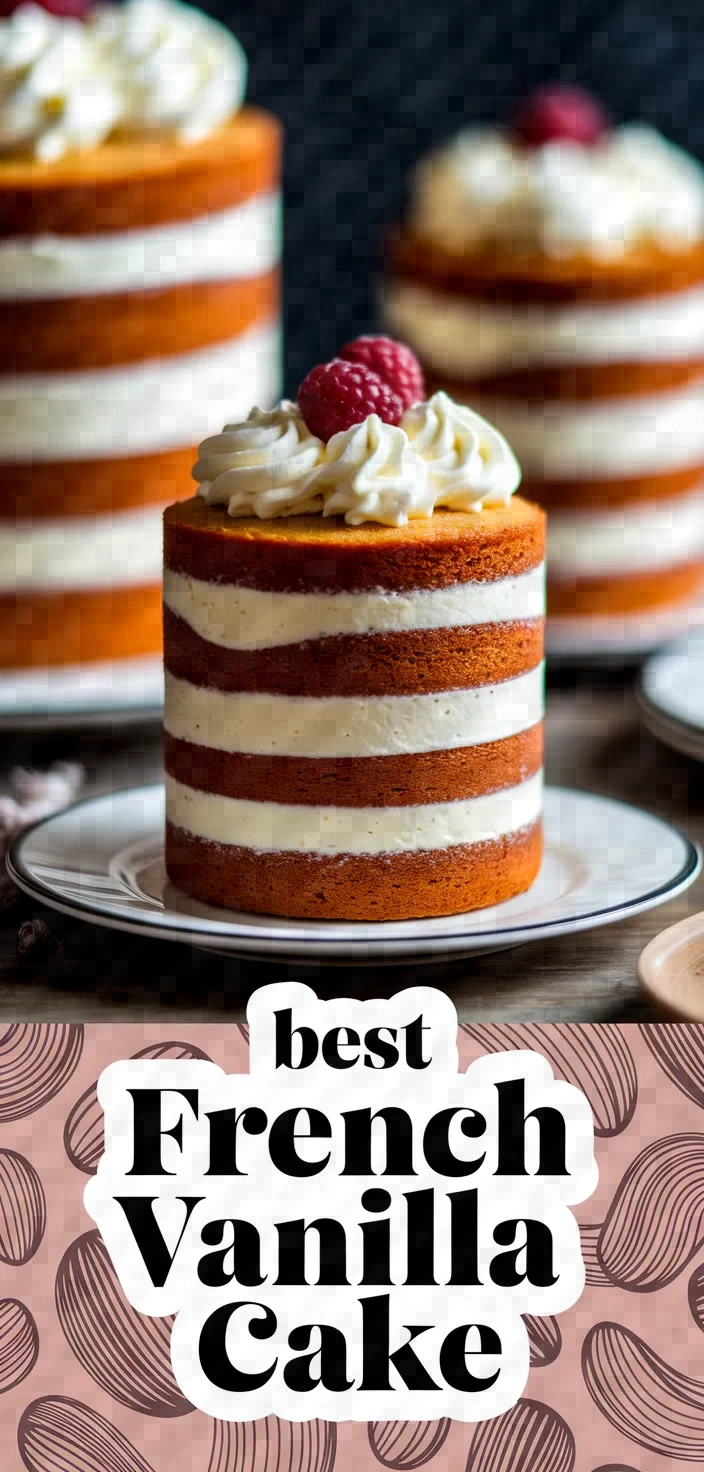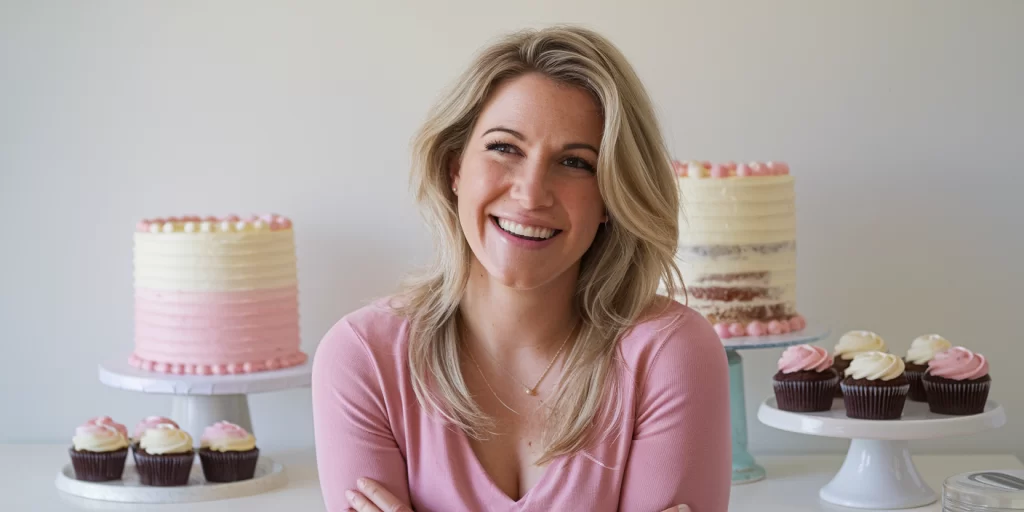I absolutely adore this recipe because it’s the perfect mash-up of nostalgia and indulgence, whisking me back to those cozy kitchen memories while delivering that irresistible vanilla allure. Creating this cake is like a therapeutic ritual, blending creamy goodness with just the right hint of sweet, leaving me eagerly anticipating that first delightful bite.

My favorite kind of recipe to create is one that showcases unfussy, high-quality ingredients, and my French Vanilla Cake does just that. It uses 2 1/2 cups of all-purpose flour and 2 1/2 teaspoons of baking powder, and then it uses 1 cup of softened, unsalted butter to bind this lovely cake together.
This is a balanced cake. It is fluffy and tender, and it has a lovely crumb.
What really makes this cake over-the-top delicious is the amount of pure vanilla extract in the batter. I have a feeling that if you were to make this cake, your taste buds would tell you the same.
And if I haven’t convinced you yet, let me layer it with the prettiest frosting and make it a cake worthy of a birthday or any other special occasion.
Ingredients

All-purpose flour:
Gives shape, is full of carbohydrates, and is essential for the texture of a cake.
Baking powder:
Baking powder makes cakes rise and gives them lightness.
Unsalted butter:
Contributes diversity, heightens taste, renders dampness and softness.
Granulated sugar:
Improves the character of cake with sweetness, good flavor, and color.
Is sugar, with its high-energy virtue and ultra-sweetness, as good a cake component as we want? Not necessarily.
Plain sugar is a very poor flavor enhancer.
That is, skin-deep sweetness is not flavor complexity.
We are obliged to go deeper if we are to have a better and more virtuous cake.
Pure vanilla extract:
Increases sweetness, deepens flavor, and makes aromatic delight.
Whole milk:
Delivers moisture, richness, and helps produce a tender crumb.
Ingredient Quantities
- 2 1/2 cups all-purpose flour
- 2 1/2 teaspoons baking powder
- 1/2 teaspoon salt
- 1 cup unsalted butter, softened
- 2 cups granulated sugar
- 4 large eggs
- 1 tablespoon pure vanilla extract
- 1 1/4 cups whole milk
Instructions
1. Set your oven to 350 degrees Fahrenheit (175 degrees Celsius) to start. While the oven warms, get two 9-inch round cake pans ready by greasing and flouring them.
2. In a medium bowl, combine the flour, baking powder, and salt. Pour through a fine-mesh sieve into the bowl. Mix together and set aside.
3. In a big mixing bowl, using an electric mixer set to medium speed, blend the softened butter and sugar together until they’re light and fluffy; this should take about 3-4 minutes.
4. Incorporate the eggs one at a time, beating well after each addition, and then blend in the vanilla extract.
5. Slowly incorporate the dry components into the creamed mixture, alternating with the milk, and starting and finishing with the dry components. Combine until you achieve a uniform batter, not a smooth one.
6. Distribute the batter equally among the cake pans you’ve prepared.
7. Preheat the oven and bake for 25-30 minutes. A toothpick inserted into the center of the cakes should come out clean when they are done.
8. After baking, allow the cakes to cool in the pans for 10 minutes. Then, turn them out onto wire racks to cool completely.
9. Frost your favorite cooled cakes with the spun sugar.
10. Cut, dish out, and indulge in your French Vanilla Cake, which is tasty and delightful!
Equipment Needed
1. Oven
2. Two 9-inch round cake pans
3. Pastry brush or paper towels (for greasing pans)
4. Flour sifter or fine-mesh sieve
5. Medium mixing bowl
6. Large mixing bowl
7. Electric mixer
8. Measuring cups
9. Measuring spoons
10. Spatula
11. Cooling racks
12. Toothpick
FAQ
- Can I use salted butter instead of unsalted butter?Correct, though it is advisable to lessen the extra sodium for better flavor harmony.
- What type of vanilla extract is best?For the best flavor, use pure vanilla extract, though for a flavor that is even more potently vanilla, consider vanilla bean paste.
- Can I replace the whole milk with a non-dairy alternative?Absolutely, you can use almond milk, soy milk, or oat milk; however, the texture might be just a bit different.
- How should I store the cake after baking?After cooling, the cake can be tightly wrapped in plastic wrap or stored at room temperature in an airtight container for up to 3 days.
- Can I make the batter ahead of time?Bake the cake right after you make the batter, for the best possible rise and texture.
- What is the best way to test if the cake is done?Put a toothpick into the center of the cake; if it comes out clean or with a few crumbs, the cake is done.
- Can I use cake flour instead of all-purpose flour?Of course, but when using cake flour, measure 2 3/4 cups because it is lighter than all-purpose flour.
Substitutions and Variations
You can use cake flour in place of all-purpose flour for a lighter texture; just use the same amount and you’ll get the same result. \- This substitution won’t work in recipes where you want the sturdiness that comes from all-purpose flour. For example: \- cookies \- your grandma’s pancake recipe \- anything where you want a chewy or dense texture.
Substitute 1/2 teaspoon of baking soda and 1 cup of plain yogurt for baking powder. When using baking soda, you must use an acid in the recipe to make it work and cause the batter to rise. Yogurt is an acid, but if you don’t want to use that much yogurt in your recipe, you could use 1/2 teaspoon of baking soda with 1/2 cup of yogurt and 1/2 cup of buttermilk (another acid) instead.
You can use the same amount of margarine or vegetable shortening to replace unsalted butter.
Granulated sugar can be substituted with 1 3/4 cups of honey, but reduce the amount of milk by 1/4 cup to maintain the desired consistency.
Buttermilk or a mixture of cream and water can replace whole milk in equal amounts. Buttermilk imparts a tangy note, while a cream-water mixture (2 parts cream to 1 part water) brings a richer flavor than whole milk.
Pro Tips
1. Room Temperature Ingredients Make sure your butter, eggs, and milk are all at room temperature before starting. This ensures that the butter creams properly with the sugar and that the batter mixes evenly, resulting in a smoother, more consistent cake texture.
2. Proper Mixing Technique When creaming the butter and sugar, mix until the mixture is pale and fluffy. This step is crucial for incorporating air into the batter, which contributes to a light and tender cake.
3. Measure Flour Accurately When measuring your flour, use the spoon-and-level method rather than scooping directly from the bag. This prevents you from adding excess flour, which can lead to a dense cake.
4. Check for Doneness Besides using a toothpick to check for doneness, gently press the center of the cake; it should spring back. This ensures that the cake is cooked through without being overbaked.
5. Cool Completely Before Frosting Ensure the cakes are completely cool before frosting to prevent the frosting from melting and the layers from sliding. If you’re in a hurry, you can refrigerate the layers to cool them faster.

Best French Vanilla Cake Recipe
My favorite Best French Vanilla Cake Recipe
Equipment Needed:
1. Oven
2. Two 9-inch round cake pans
3. Pastry brush or paper towels (for greasing pans)
4. Flour sifter or fine-mesh sieve
5. Medium mixing bowl
6. Large mixing bowl
7. Electric mixer
8. Measuring cups
9. Measuring spoons
10. Spatula
11. Cooling racks
12. Toothpick
Ingredients:
- 2 1/2 cups all-purpose flour
- 2 1/2 teaspoons baking powder
- 1/2 teaspoon salt
- 1 cup unsalted butter, softened
- 2 cups granulated sugar
- 4 large eggs
- 1 tablespoon pure vanilla extract
- 1 1/4 cups whole milk
Instructions:
1. Set your oven to 350 degrees Fahrenheit (175 degrees Celsius) to start. While the oven warms, get two 9-inch round cake pans ready by greasing and flouring them.
2. In a medium bowl, combine the flour, baking powder, and salt. Pour through a fine-mesh sieve into the bowl. Mix together and set aside.
3. In a big mixing bowl, using an electric mixer set to medium speed, blend the softened butter and sugar together until they’re light and fluffy; this should take about 3-4 minutes.
4. Incorporate the eggs one at a time, beating well after each addition, and then blend in the vanilla extract.
5. Slowly incorporate the dry components into the creamed mixture, alternating with the milk, and starting and finishing with the dry components. Combine until you achieve a uniform batter, not a smooth one.
6. Distribute the batter equally among the cake pans you’ve prepared.
7. Preheat the oven and bake for 25-30 minutes. A toothpick inserted into the center of the cakes should come out clean when they are done.
8. After baking, allow the cakes to cool in the pans for 10 minutes. Then, turn them out onto wire racks to cool completely.
9. Frost your favorite cooled cakes with the spun sugar.
10. Cut, dish out, and indulge in your French Vanilla Cake, which is tasty and delightful!










